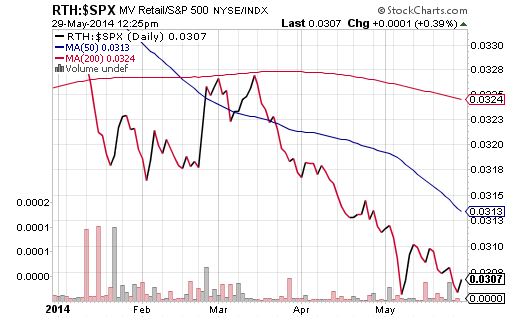Home Depot (NYSE:HD), Target (NYSE:TGT), Dick's Sporting Goods (NYSE:DKS), Staples (NASDAQ:SPLS), PetSmart (NASDAQ:PETM), Sears (NASDAQ:SHLD), Lowe's (NYSE:LOW), Walmart (NYSE:WMT). What do all of these companies have in common? They sell products to the middle class. Lately, however, these retailers have not been selling a whole of their wares to middle class consumers. Not only did they reveal disappointing top-line revenue numbers in the first quarter, sales weakness has been evident in April and May as well.
Conventional writers in the financial media have been blaming lower-than-anticipated sales on unusually harsh weather in the first few months of 2014. Unfortunately, that notion does not even stand up to the mildest of scrutiny. For one thing, the snowstorms have disappeared, while the retailers continue to flounder. Equally telling, stock shares of high-end retailers like Tiffany (NYSE:TIF) and Nordstrom Inc (NYSE:JWN) have been skyrocketing on better-than-expected profitability. At the same time, brand-name corporations that serve the middle class are witnessing an erosion in their share prices. This deterioration can be seen when one compares an exchange-traded fund like Market Vectors Retail (NYSE:RTH) with a broader benchmark like the S&P 500.
Retailer shares notwithstanding, the S&P 500 is notching record highs. One might think that the retrenchment in middle class spending would give stock investors pause. After all, how many times do we hear that the consumer represents 70% of the domestic economy?
Perhaps the greatest irony derives from the recent realization that overall consumer spending actually grew 3.1% between January and March. Out of one side of their mouths, spin-doctors speak about weather conditions adversely impacting consumption at major retail stores. Out of the other? The increases in consumption are a sign that Americans are feeling more confident about the future. Never mind the fact that the overall economy actually shrank a full percentage point in the first quarter; never mind the actuality that overall consumption is attributable to greater health care costs and monstrous heating bills. If middle class Americans were truly feeling more confident, we’d see discretionary dollars being used at “marts” like Walmart and Petsmart as well as home improvement stores like Home Depot and Lowe’s.
From an investment standpoint, one should avoid ETFs like Market Vectors Retail (RTH) and SPDR Select Sector Consumer Discretionary (ARCA:XLY). What about the broader U.S. stock market? The noteworthy decline in bond yields offers sufficient cover to pick up a bit more broad market exposure on down days. Americans may or may not be feeling confident about the future, but they certainly respond to lower borrowing costs.

Remember when every Tom, Dick and Gary insisted that interest rates were going to rise in 2014? Well, not every Gary. There are a few of us who expected rates to fall.
Keep in mind, the U.S. Federal Reserve is holding onto roughly 40% of all U.S. Treasuries over five years in maturity. Even with tapering, the Fed is still acquiring an astounding chunk of sovereign debt in existence with the current pace of bond buying at $45 billion per month. It follows that there are not a whole lot of bonds left out there for foreign governments, global investors, pensions and private citizens. Even modest demand for safety or yield can move the needle when supply is limited. Prices go up, yields go down.
U.S. stocks as an asset class are likely to hold up for as long as the Fed can engineer a low interest rate environment. With the 10-year now at 2.45% and falling, even recent declines in real estate sales may reverse themselves; cheaper mortgage payments would improve affordability.
Still, my preference on U.S. assets is to own “value.” I cannot wrap my head around the exorbitant prices that some have been willing to shell out for “Twitters” (NYSE:TWTR) and “Teslas” (NASDAQ:TSLA). I still prefer the dividend producing technology corporations that trade at venerable discounts to the broader S&P 500. Oracle (NYSE:ORCL), Microsoft (NASDAQ:MSFT), Apple (NASDAQ:AAPL), IBM (NYSE:IBM)— these are the “old tech” leaders that you can get in First Trust Technology Dividend (NASDAQ:TDIV).
“Growth” is still worth owning, but only at reasonable prices. That means you should be looking overseas in your ETF selection process. You can get a basket of profitable Asian corporations for a price that you might have paid three years ago. I favor iShares MSCI Asia excluding Japan (NASDAQ:AAXJ).
Disclosure: Gary Gordon, MS, CFP is the president of Pacific Park Financial, Inc., a Registered Investment Adviser with the SEC. Gary Gordon, Pacific Park Financial, Inc, and/or its clients may hold positions in the ETFs, mutual funds, and/or any investment asset mentioned above. The commentary does not constitute individualized investment advice. The opinions offered herein are not personalized recommendations to buy, sell or hold securities. At times, issuers of exchange-traded products compensate Pacific Park Financial, Inc. or its subsidiaries for advertising at the ETF Expert web site. ETF Expert content is created independently of any advertising relationships.


